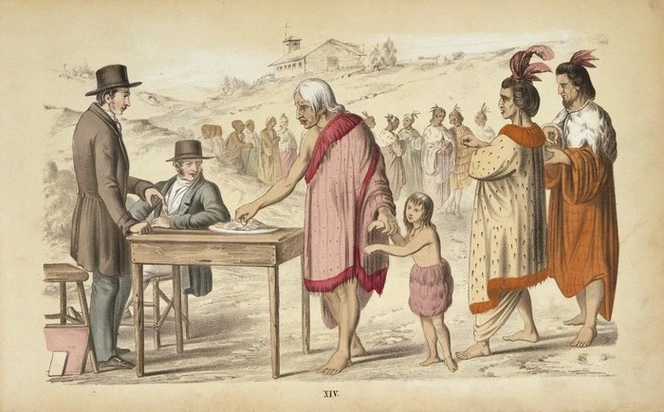Nopera Panakareao was a rangatira (leader) of the Te Pātū hapū of Te Rarawa in the first half of the 19th century. Nopera converted to Christianity, taking a Christian name (Nopera is a transliteration of ‘Noble’), and entered into good faith trade and land transactions with English settlers, who were then very actively colonising the far north of Aotearoa, including the lands around his home near what is now Kaitaia.
Nopera signed He Whakaputanga, the 1835 Declaration of Independence, and the 1840 Te Tiriti o Waitangi (the Treaty of Waitangi) when it was brought to Kaitaia on the 28th of April 1840, two months after the historic hui at Waitangi. At the Kaitaia signing hui, his support for the Treaty is recorded as important to its success.
On that occasion, he encouraged his kinfolk to sign by saying, ‘Only the shadow of the land will go to the Governor, but the substance will remain with us.’ But, within a year, he had to admit that the truth was the exact opposite, as the land was being lost to the British settlers, with only the shadow of the land remaining with the traditional Māori owners. This image fits Māori ontologies today since Māori people still belong to their ancestral lands despite having no material access to or use of any part of that real estate.
Steven Webster refers to this memorable metaphor in his analysis of the disjunction between the socioeconomic circumstances of Māori people and the postmodernist representations of Māori culture. He cautions that it is important not to be confused between the ideology of culture and the ‘market forces’ that it may mystify. ‘It is only the appearances of a culture which can be appropriated and exploited; meanwhile, the real thing – the other side of culture in an ideological sense – remains in the hands of those whose culture it is.’
Webster concludes that, unlike Māori land, only the shadow of Māori culture can ever be captured by Pākehā or the government. But while Māori culture is thus inalienable, Māori cannot eat their culture any more than they can eat the shadow of their land. This analysis clarifies why Pākehā institutions can never fully capture or reflect te ao Māori worldviews. The ‘inclusion’ of Māori culture by Pākehā in educational and academic practice is only ever symbolic. Pākehā use of Māori greetings in emails, insistence on starting meetings (even online meetings) with karakia, bilingual signage – where does the gesture meet reality? Te reo Māori is one of the very few indigenous languages ever to be accorded the status of an official national language, but is this status, too, merely a symbolic gesture? What does it actually mean to ‘honour the Treaty’?
These are large questions, but on a smaller scale, Webster’s insights challenge non-Māori to think about the difference between dealing with such trappings of Māori culture and with Māori people themselves. Otherwise, the symbolic gesturing of the descendants of the colonisers, justified in the name of cultural responsiveness, can easily cause fresh harm to the grandchildren of the colonised. There is a subtle but undeniable difference between when a Māori person offers a karakia or mihi and when a non-Māori person does the exact same thing. Non-Māori would do well to remember that Māori culture will always belong to Māori people.




